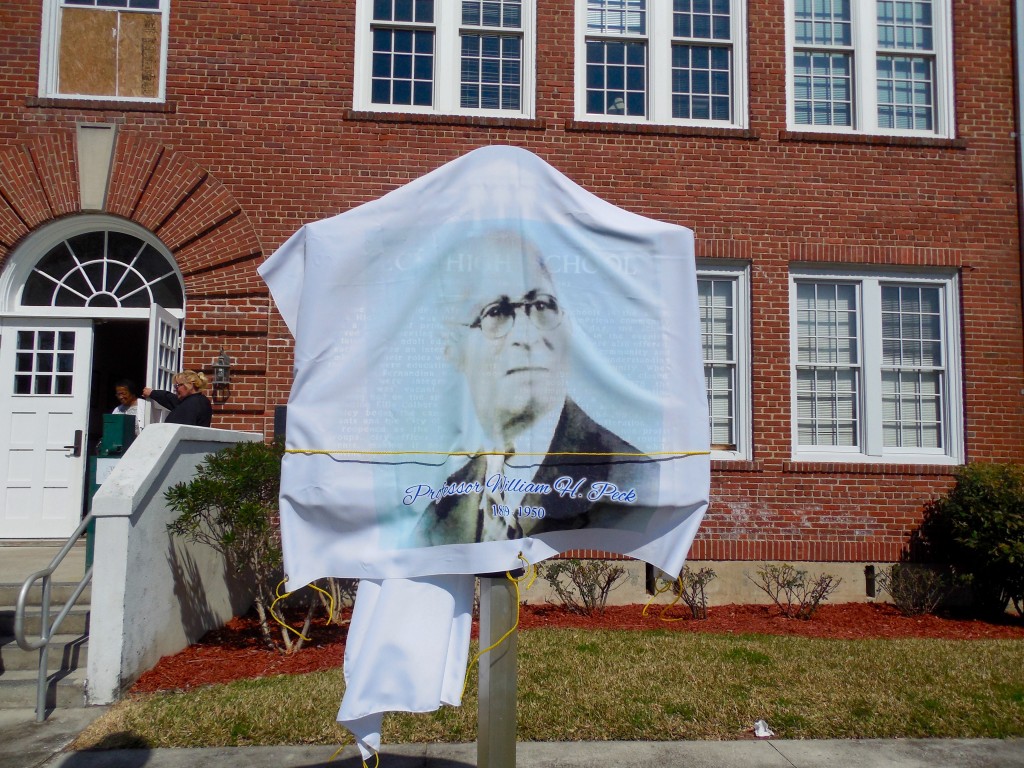Submitted by Suanne Z. Thamm
Reporter-News Analyst
February 19, 2016 4:31p.m.

The following information appears on the Peck historic marker, unveiled at the Peck Center on February 19, 2016:
A FLORIDA HERITAGE SITE
SPONSORED BY PECK ALUMNI ASSOCIATION, CITY OF FERNANDINA BEACH, AND THE FLORIDA DEPARTMENT OF STATE
2015
SIDE ONE:
The groundwork for Peck High School started in 1880, when a group led by Henry B. Delaney petitioned for an African American school in Fernandina. In 1885, a four-room building known as Colored School No. 1 opened at Atlantic Avenue and 11th Street. Moses H. Payne, a Howard University graduate, became the first principal and teacher that same year. William H. Peck, also a Howard graduate, joined Payne in Fernandina in 1887, and served as assistant principal. Following Payne’s death in 1888, Peck was promoted to principal, a position he held until 1931. Professor Peck developed the high school’s curriculum and graduated its first class in 1891. In 1909, a four acre parcel was purchased on South 10th Street to build a larger school. Peck tenaciously gathered support from within the community and from the Rosenwald Foundation, a program for African-American school construction funded by Julius Rosenwald of Sears, Roebuck & Co. In 1911, the school was renamed in Peck’s honor. Peck High School was completed in 1927, serving grades 1-12. Peck, who died in 1950 and is buried at Bosque Bello cemetery, was widely respected in the community and recognized in the state’s Great Floridians 2000 program.
SIDE TWO:
As one of the oldest African American high schools in the state, Peck High School was the center of the African American community and a source of pride. Used for classes in the day, the school served as a meeting place for community groups in the evening. In later years, adult education and industrial skills were also offered. Teachers were an integral part of the fabric of the community and embraced their roles with great pride and commitment, understanding that they were educating students, families, and a community. When schools in Fernandina were desegregated in 1969, Peck was closed. Students were integrated into other schools and by 1976 the building was vacant. Recognizing the impact the deteriorating building had on the spirit of an entire community, a diverse group including Ellie Colburn, Elmo Myers, Charles Albert, and Willie Mae Ashley began the campaign to save Peck High. In the 1990s, state grants and the City of Fernandina Beach funded its restoration, and it reopened as the Peck Center. The center houses non-profit groups, city offices, and hosts recreational activities and special events, making it possible for Peck to celebrate its past while continuing to serve the community.

 Editor’s Note: Suanne Z. Thamm is a native of Chautauqua County, NY, who moved to Fernandina Beach from Alexandria,VA, in 1994. As a long time city resident and city watcher, she provides interesting insight into the many issues that impact our city. We are grateful for Suanne’s many contributions to the Fernandina Observer.
Editor’s Note: Suanne Z. Thamm is a native of Chautauqua County, NY, who moved to Fernandina Beach from Alexandria,VA, in 1994. As a long time city resident and city watcher, she provides interesting insight into the many issues that impact our city. We are grateful for Suanne’s many contributions to the Fernandina Observer.
